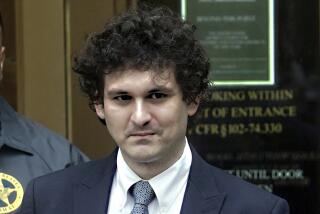Schwab Resigns From Board of BankAmerica : Reportedly Frustrated and Wanted to Buy Discount Brokerage Firm Back
- Share via
SAN FRANCISCO — Charles R. Schwab, who sold his discount brokerage firm to BankAmerica in 1983 and quickly came to regret it, resigned Wednesday as a director of beleaguered BankAmerica and of its Bank of America subsidiary.
The 49-year-old entrepreneur, who will stay on as chairman and chief executive of the highly successful Charles Schwab & Co., said in a prepared statement that he wanted to “devote undivided time and attention” to the firm he founded in 1974.
Schwab was not available for further comment, but associates said his decision to quit capped a long period of frustration with BankAmerica. “Chuck has been an unhappy board member for some time,” said Andrew F. Brimmer, a BankAmerica board member who is president of a Washington economic and financial consulting firm that bears his name.
Firm Not for Sale
“He wants to buy his company back,” Brimmer added, even though “it was made clear to him, very explicitly, that Charles Schwab & Co. is not for sale.” The discount brokerage firm, one of the few bright spots at loss-ridden BankAmerica, expects net income of $30 million this year, according to Hugo Quackenbush, senior vice president for marketing.
Rebuffed first by Samuel H. Armacost, BankAmerica’s president and chief executive, last November, Schwab has been unable to muster much support among fellow board members for his plan to sell what is now the nation’s largest discount brokerage firm to the public and to the firm’s management.
Schwab’s is the second high-level resignation announced by BankAmerica this week. On Monday, John S. Poelker quit as executive vice president, chief financial officer and treasurer.
Though the two resignations seem unrelated, both came less than a month after BankAmerica stunned the financial community with the announcement that it had lost $640 million during the second quarter of 1986.
“Whatever reasons they give, you’ve got to assume that both men would have stayed around had BankAmerica’s prospects been better,” one San Francisco banker said.
The unhappy marriage began in January, 1983, when Schwab and his fellow shareholders agreed to sell Charles Schwab & Co. to BankAmerica for 2.6 million B of A shares, then worth $54 million. Schwab and his wife received 1,002,000 of those shares, though by Dec. 31, 1985, the disillusioned Schwab had sold all but 61,650 of them.
BankAmerica’s stock, trading at about $21 a share at the time of the deal, never rose much higher despite one of the most powerful bull markets in history and closed Wednesday at $12.37 1/2 a share.
Still, one friend noted that Schwab remains a wealthy man and may have stepped down to avoid any personal liability as a BankAmerica director.
BankAmerica self-insures its officers and directors through a subsidiary it owns in the Cayman Islands as a result of the cancellation last year of its directors’ and officers’ liability policy by Wausau Insurance.
At the time of the acquisition, Armacost said he hoped that Schwab’s entrepreneurial skills would rub off on the more bureaucratic BankAmerica. There were also high hopes for joint product offerings.
It hasn’t worked out that way. Corporate cultures collided almost immediately when Schwab tried to meld its Porsche and BMW-laden automobile fleet with BankAmerica’s Plymouths, Buicks and Lincolns.
Schwab himself rebelled openly when Bank of America’s real estate bureaucracy tried to relocate his operation to a windowless old department store on a seedy stretch of San Francisco’s Market Street.
Complaining to Armacost that his employees would be known as “the moles of Wall Street,” he eventually won his own 28-story skyscraper on downtown’s Montgomery Street.
More to Read
Inside the business of entertainment
The Wide Shot brings you news, analysis and insights on everything from streaming wars to production — and what it all means for the future.
You may occasionally receive promotional content from the Los Angeles Times.










